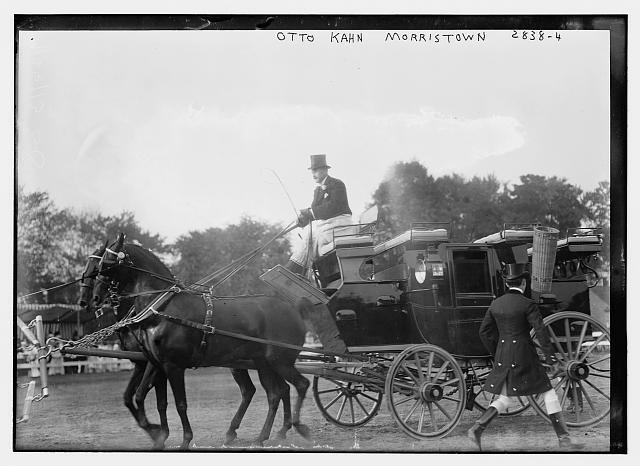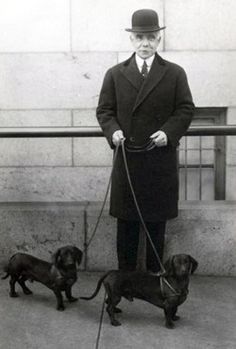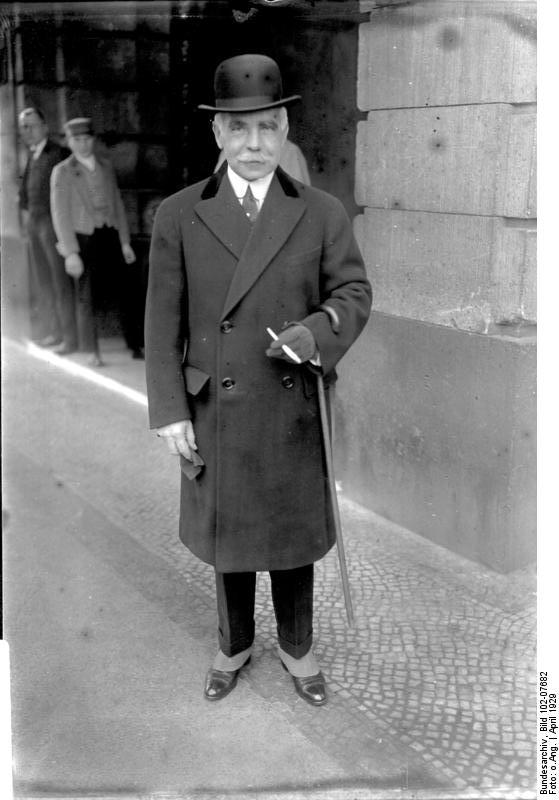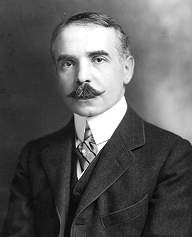Otto Hermann Kahn (1867-1934).
- Profession: Banker, financier, director Metropolitan Opera, philanthropist.
- Residences: Mannheim, New York.
- Relation to Mahler: Although mahler had abandoned his post as Metropolitan Opera conductor, he and Alma were still on good terms with Otto Kahn and his wife. see Eusapia Palladino (1854-1918) in 01-1910 / 03-1910
- Correspondence with Mahler:
- Born: 21-02-1867 Mannheim, Germany.
- Married Addie Kahn-Wolff
- Died: 29-03-1934 Manhattan, New York, America.
- Buried: Saint John’s cemetery, Laurel Hollow, New York, America. Funeral services were held in the music room of his Long Island estate.
Otto Hermann Kahn was an investment banker, collector, philanthropist, and patron of the arts. He was born on February 21, 1867 in Mannheim, Germany, and raised there, by his Jewish parents, Emma (née Eberstadt) and Bernard Kahn. His father had been among the refugees to the United States after the revolution of 1848 and had become an American citizen, but later returned to Germany. Kahn was educated in a gymnasium in Mannheim.
Kahn’s ambition was to be a musician, and he learned to play several instruments before he graduated from the gymnasium, but he was one of eight children, and his father had set plans for the career of each one. Kahn he destined to be a banker. At 17, Kahn was placed in a bank at Karlsruhe as a junior clerk, where he remained for three years, advancing until he was thoroughly grounded in the intricacies of finance. He then served for a year in the Kaiser’s hussars.
On leaving the army he went to the London agency of Deutsche Bank, where he remained five years. He displayed such unusual talents that he became second in command when he had been there but a comparatively short time. The English mode of life, both political and social, appealed to him, and eventually he became a naturalized British subject.
In 1893, he accepted an offer from Speyer and Company of New York and went to the United States, where he spent the rest of his life. On January 8, 1896, Kahn married Addie Wolff and following the couple’s year-long tour of Europe, Kahn joined Kuhn, Loeb & Co. in New York City, where his father-in-law, Abraham Wolff, was a partner. In 1917, Kahn gave up his British nationality and became a United States citizen.

Otto Hermann Kahn (1867-1934) in Morristown, 1910.
Besides his father-in-law, Kahn’s other partners included Jacob Schiff, himself the son-in-law of Solomon Loeb, who co-founded the firm, and Paul and Felix Warburg. Almost immediately, Kahn was thrown into contact with railroad builder E. H. Harriman. In spite of sharply defined differences in temperament and method, they became as brothers. In opposition to Harriman’s gruff, domineering, aggressive manner in business, was Kahn’s calm, good-humored, almost gentle deportment. Kahn, although only 30 years old, took an almost equal part with Harriman in the gigantic task of reorganizing the Union Pacific Railroad, a work which in its early stages had been handled by Schiff. Kahn proved his ability to analyze mathematically and scientifically the problems that were constantly presented.
Kahn was soon to be acknowledged as the ablest reorganizer of railroads in the United States. He applied himself to the Baltimore and Ohio Railroad, the Missouri Pacific Railroadthe Wabash Railroad, the Chicago and Eastern Illinois Railroad, the Texas and Pacific Railroad, and other systems. More than once, his prompt and vigorous action averted an imminent financial panic. A notable instance was his rescuing from collapse the Pearson-Farquhar syndicate when it found itself in deep water in an attempt to combine several existing lines of railroad into a South American transcontinental system.
When American International Corporation was forming, Kahn took an active part in the negotiations, and brought them to a successful issue. Kahn conducted negotiations which led to the opening of the doors of the Paris Bourse to American securities and the listing there of $50,000,000 Pennsylvania bonds in 1906, the first official listing of American securities in Paris. Also he had a large share later in the negotiations which resulted in the issue by Kuhn, Loeb and Company of $50,000,000 of City of Paris bonds and $60,000,000 Bordeaux-Lyons and Marseilles bonds.

Otto Hermann Kahn (1867-1934) with his dachshunds.
In 1933, the smooth and affable Kahn successfully disarmed antagonism against members of the banking community during four days of testimony before the United States Senate’s Pecora Commission hearings into the Wall Street Crash of 1929. The Senate’s lead counsel Ferdinand Pecora wrote on page 293 in his 1939 memoir Wall Street Under Oath about Otto Kahn: “No suaver, more fluent, and more diplomatic advocate could be conceived. If anyone could succeed in presenting the customs and functions of the private bankers in a favorable and prepossessing light, it was he.”
Kahn was a trustee of the Massachusetts Institute of Technology and of Rutgers College. He was a director in numerous corporations, including the Equitable Trust Co. of New York and the Union Pacific Railroad.
During the last years of Kahn’s life he became increasingly frail and suffered from arteriosclerosis, high blood pressure and attacks of angina pectoris. On March 29, 1934, following lunch in the private dining room of Kuhn, Loeb & Co., Kahn suffered a massive heart attack and died, aged 67. Funeral services were held in the music room of his Long Island estate, followed by a burial in nearby St. John’s Memorial Cemetery.
Patron of the arts
An extremely wealthy financier, Kahn supported artists such as Hart Crane, George Gershwin and Arturo Toscanini. He was also smitten with Hollywood, to which Kuhn Loeb provided much commercial support and Kahn, personal support. In her second full-length film, Be Yourself, Fanny Brice sang a song that mentioned Kahn: “Is something the matter with Otto Kahn, or is something wrong with me? I wrote a note and told him what a star I would make. He sent it back and marked it “Opened by mistake.” He was parodied as Roscoe W. Chandler in the stage and film versions of the Marx Brothers’s Animal Crackers.
Kahn was chairman of the New York committee of the Shakespeare Tercentenary (1916). He was elected to honorary membership in Phi Mu Alpha Sinfonia music fraternity by the Fraternity’s Alpha Chapter at the New England Conservatory in 1917. He was chairman of the board of directors of the Metropolitan Opera Company of New York and of the French Theatre of New York and a founder and later treasurer of the New Theatre Company.

Otto Hermann Kahn (1867-1934) in Berlin, 1931.
More
Financier, Investment Banker, and Philanthropist. Born Otto Hermann Kahn, the 5th of eight children to Jewish parents in Mannheim, Germany, he desired to become a musician, and learned to play several instruments before graduating from his secondary education in Mannheim. His father had set plans for him to become a banker and at the age of 17, he was placed in a bank at Karlsruhe, Germany as a junior clerk, where he remained for three years. At the age of 21, he served in the Kaiser’s hussars, a light cavalry military organization, for a year.
After leaving the army, he went to the London, England agency of Deutsche Bank, where he remained five years, displaying such unusual talents that he became second in command when he had been there but a comparatively short time. The English mode of life, both political and social, appealed to him, and eventually he became a naturalized British citizen. In 1893 he accepted an offer from Speyer and Company of New York City, New York and immigrated to the US, where he spent the rest of his life. In January 1896 he married Addie Wolff, the daughter of financier Abraham Wolff, and following the couple’s year-long tour of Europe, he joined the firm of Kuhn, Loeb & Co. in New York City, where his father-in-law was a partner. He was introduced to railroad builder E. H. Harriman and in spite of sharply defined differences in temperament and method, they became close.
Although only 30 years old at the time, he took an almost equal part with Harriman in the gigantic task of reorganizing the Union Pacific Railroad, proving his ability to analyze mathematically and scientifically the problems that were constantly presented. He soon became known as the ablest reorganizer of railroads in the US, and applied himself to the Baltimore and Ohio Railroad, the Missouri Pacific Railroad, the Wabash Railroad, the Chicago and Eastern Illinois Railroad, the Texas and Pacific Railroad, and other rail systems. His prompt and vigorous action averted an imminent financial panic on several occasions. In 1917 he surrendered his British nationality and became a US citizen. In 1933 he was successful in disarming antagonism against members of the banking community during four days of testimony before the US Senate’s Pecora Commission hearings into the Wall Street Crash of 1929.
During the last years of his life, he became increasingly frail and suffered from arteriosclerosis, high blood pressure and attacks of angina pectoris. An extremely wealthy financier, he supported artists such as poet Hart Crane, music composer and pianist George Gershwin, and orchestra conductor Arturo Toscanini. He died from a massive heart attack in New York City at the age of 67. A patron of the arts, he served as a trustee of the Massachusetts Institute of Technology in Cambridge, Massachusetts and of Rutgers College in Camden, New Jersey. He was the chairman of the New York committee of the Shakespeare Tercentenary (1916) and was elected to honorary membership in Phi Mu Alpha Sinfonia music fraternity by the Fraternity’s Alpha Chapter at the New England Conservatory in 1917.
He was chairman of the board of directors of the Metropolitan Opera Company of New York and of the French Theatre of New York and a founder and later treasurer of the New Theatre Company. He was also a director in numerous corporations, including the Equitable Trust Co. of New York and the Union Pacific Railroad.
His country home on Long Island, named Oheka Castle, was the second largest private residence in the US at 109,000 square feet. His home in New York City, built in 1918, was an 80-room Italian Renaissance-palazzo style mansion, modeled after the Cancelleria in Rome, Italy.

